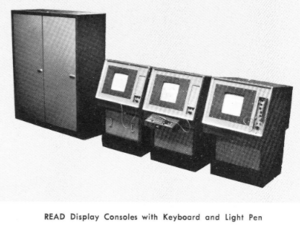Difference between revisions of "Stanford Time-Sharing System"
From Computer History Wiki
(Picture of Philco displays.) |
(→External links: Ellis D. Kropotechev and Zeus, This marvelous time-sharing system.) |
||
| Line 15: | Line 15: | ||
* [https://exhibits.stanford.edu/cs/feature/time-sharing-memos Time-Sharing Memos at Stanford] | * [https://exhibits.stanford.edu/cs/feature/time-sharing-memos Time-Sharing Memos at Stanford] | ||
** [https://exhibits.stanford.edu/ai/catalog/mj602vm6318 Memo 32: TVEDIT] | ** [https://exhibits.stanford.edu/ai/catalog/mj602vm6318 Memo 32: TVEDIT] | ||
| − | * [http://www-forum.stanford.edu/wiki/index.php?title=Early_Computers_at_Stanford#DEC_PDP-1 Early Computers at Stanford] | + | * [http://www-forum.stanford.edu/wiki/index.php?title=Early_Computers_at_Stanford#DEC_PDP-1 Early Computers at Stanford] - PDP-1 |
* [http://www.bitsavers.org/pdf/stanford/pdp1/ Bitsavers documents about the Stanford PDP-1] | * [http://www.bitsavers.org/pdf/stanford/pdp1/ Bitsavers documents about the Stanford PDP-1] | ||
| + | * [https://www.youtube.com/watch?v=Dv5shcFi-og Ellis D. Kropotechev and Zeus, This marvelous time-sharing system] | ||
[[Category: Operating Systems]] | [[Category: Operating Systems]] | ||
Latest revision as of 05:38, 12 June 2023
Stanford Time-Sharing System was the formal name for a series of experimental time-sharing systems at Stanford, called Thor, Odin, and Zeus. They ran on a PDP-1 in Pine Hall, which was shared between Patrick Suppes at IMSSS and John McCarthy's newly started AI project.
The system had twelve Philco vector displays.
There was a very early full-sceen text editor called TVEDIT, written by Brian Tolliver.
Both the hardware and software influenced the time-sharing system on the SAIL PDP-6.
